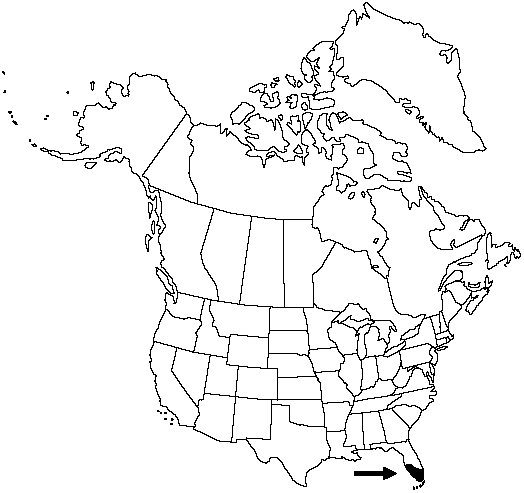Nephrolepis ×averyi
Amer. Fern J. 69: 69. 1979.
Stem scales loosely appressed to spreading, essentially concolored. Tubers absent. Leaves 8–30 × 0.5–1.3 dm. Petiole 1.2–5 dm, moderately to densely scaly; scales spreading, reddish to light-brown throughout. Blade moderately scaly, glabrous to occasionally pubescent abaxially, glabrous adaxially, hairs pale to light-brown, 0.2–0.7 mm. Rachis 5–26 dm, points of pinna attachment 9–25 mm apart; scales scattered, brown throughout. Central pinnae narrowly deltate to oblong-deltate, 3.6–9 × 0.7–2 cm, base truncate, sometimes rounded basiscopically, barely auriculate acroscopically, acroscopic lobe obtuse to acute, margins serrulate, apex narrowly acute to attenuate, falcate to slightly so; costae adaxially sparsely pubescent, hairs pale, erect, 0.1–0.5 mm. Indusia horseshoe-shaped to circular, attached at narrow sinus or peltate, 0.9–1.1 mm wide. 2n = 164.
Habitat: Terrestrial or epiphytic in forested, often moist habitats, e.g., swamps, hammocks, or relatively open, disturbed habitats
Elevation: 0 m
Distribution

Fla., Mexico, West Indies
Discussion
Nephrolepis × averyi is an allotetraploid derived from hybridization between N. biserrata and N. exaltata and is known to occur only in mixed populations of both parent species. It is distinguished from N. exaltata by its sparsely hairy adaxial costae, larger size, and misshapen spores, and from N. biserrata by its falcate pinnae and narrower leaves.
Selected References
None.
Lower Taxa
"dm" is not declared as a valid unit of measurement for this property."dm" is not declared as a valid unit of measurement for this property."/10lengthofblade" is not declared as a valid unit of measurement for this property."dm" is not declared as a valid unit of measurement for this property.